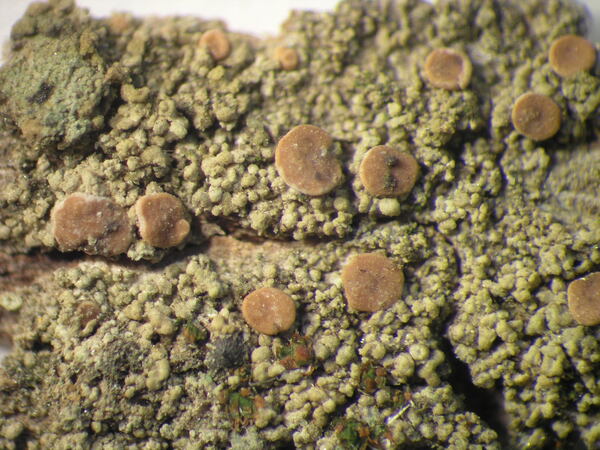Bacidia iberica Aragón & I. Martínez
Bryologist, 106: 143, 2003.
Synonyms:
Distribution: C - Tosc (Anzi Lich. Etr. Rar. Exs. 23, see note).
Description: Thallus crustose-subsquamulose, episubstratic, greenish grey, consisting of ascending, flattened, (0.16-)02-0.3 mm long areoles-squamules with crenate to subdigitate margins. Upper cortex paraplectenchymatous, inspersed with small crystals dissolving in K but not in N. Apothecia lecideine, round, sessile and constricted at base, (0.4-)0.6-1.2(-1.6) mm across, with a flat, yellow-orange to orange disc, and a slightly paler, smooth proper margin. Proper exciple psosoplectenchymatous, 55-97 μm wide laterally, the outer part with more or less isodiametrical cells and with crystals dissolving in N but not in K, the inner part with enlarged cells; epithecium colourless to pale yellow, without crystals; hymenium colourless, 50-95 μm high; paraphyses simple or sparingly branched, 1-1.5 μm thick at mid-level, the apical cells 2-3.3 μm wide; hypothecium colourless to pale yellow, 50-80 μm high. Asci 8-spored, clavate to cylindrical-clavate, the apical dome K/I+ dark blue with a pale, conical-pointed apical cushion (axial mass), the wall I-, but the thin outer gel I+ blue, Bacidia-type. Ascospores 5-9-septate, hyaline, needle-like, straight, 42-58 x 2-3.5 μm. Photobiont chlorococcoid. Spot tests: thallus K- or K+ yellowish brown, C-, KC-, P-. Chemistry: cortex with low amounts of atranorin; apothecia with the Rubella-orange pigment.Note: a Mediterranean epiphytic species, similar to B. rubella but differing in the squamulose thallus and other morphological characters. The sample from Tuscany is a duplicate of B. rubella distributed by Anzi, kept in LD (nr. 1186097), and revised by E. Llop in 2005.
Growth form: Crustose
Substrata: bark
Photobiont: green algae other than Trentepohlia
Reproductive strategy: mainly sexual
Commonnes-rarity: (info)
Alpine belt: absent
Subalpine belt: absent
Oromediterranean belt: absent
Montane belt: absent
Submediterranean belt: absent
Padanian area: absent
Humid submediterranean belt: absent
Humid mediterranean belt: very rare
Dry mediterranean belt: absent

Predictive model
Growth form: Crustose
Substrata: bark
Photobiont: green algae other than Trentepohlia
Reproductive strategy: mainly sexual
Commonnes-rarity: (info)
Alpine belt: absent
Subalpine belt: absent
Oromediterranean belt: absent
Montane belt: absent
Submediterranean belt: absent
Padanian area: absent
Humid submediterranean belt: absent
Humid mediterranean belt: very rare
Dry mediterranean belt: absent

Predictive model
 INDEX FUNGORUM
INDEX FUNGORUM
 GBIF
GBIF


